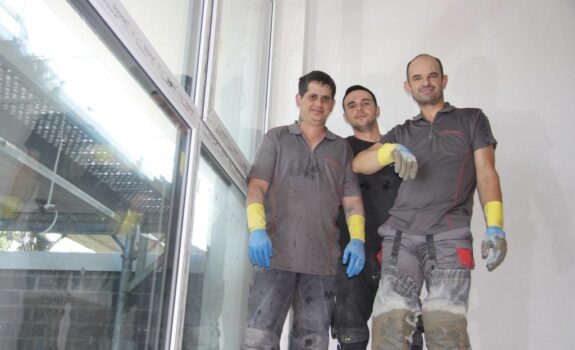Interior plaster & exterior plaster
There are different types of plasters, but they all consist of the same mixture:
Sand, water and a binder. Mineral, inorganic binders include, for example, clay, cement, lime or gypsum, while synthetic resin is an organic binder. To obtain further useful properties, other additives such as gravel or glass fibre are mixed into the plaster.
The thickness of the plaster is just as important. Thick plasters include, for example, underplasters. A base coat is intended to level out unevenness and optimally prepare the surface for the finishing plaster. This can be a thick-layer plaster or a thin-layer plaster and is the last visible layer of plaster. The finishing plaster is therefore also referred to as a noble plaster and can have a great influence on the façade design. However, both plaster layers must be coordinated with each other, otherwise cracks and instability can occur.
We work with future-proof materials and building materials in the field of exterior and interior plaster.
Our services in the field of exterior and interior plastering:
- Exterior plaster
- Interior plaster
- Mineral plaster
- Silicone resin plaster
- Clay plaster
- Scratch coat plaster
- Roller plaster
- Plasterer
- Filler work
Depending on the substrate and condition of the façade, different building materials come into question.
The selection of the right materials and tools plays an important role.
If you have any further questions about exterior and interior plastering, we will be happy to help you.
We are also happy to offer comprehensive advice on site.
Interior plaster
Plastering is very important indoors because a smooth surface must be created for wall coverings. Wallpaper or tiles will hold optimally if the walls have been properly finished and plastered. However, the interior plaster on the interior façade also fulfils other important functions:
- Has an insulating function
- Airtightness level for the building envelope
- Create a flat, refined wall surface
- Create a pleasant living atmosphere
- Regulates the humidity in the room
- Impedes the formation of mould
- Regulating sound insulation
- Fire protection
Exterior plaster
Exterior rendering consists of four basic functions: Aesthetics, weather protection, insulation and substance preservation.
Most plasters are mineral plasters, but there are exceptions. The fast-hardening, organic synthetic resin plasters are especially important for thermal insulation. They are also weather-resistant (e.g. hail, rain), water-repellent and very flexible. Thus, they adapt to temperature and humidity conditions.
However, they are not breathable, which is why the surface needs a longer time to dry after getting wet. This leads to a faster formation of algae, moss and fungi. This can be counteracted with special additives within the synthetic resin plaster or by directly using silicone resin plasters, because in addition to their similar properties, silicone resin plasters also offer particularly good protection against moss and algae growth.
Functions of the exterior plaster:
- Schutz der Wände vor Witterungseinflüssen und Feuchtigkeit
- Gestaltung der Fassade
- Wärmeschutz
- Dämmung
- Substanzerhalt
- Dampfdurchlässigkeit und Feuchtigkeitsabsorption
